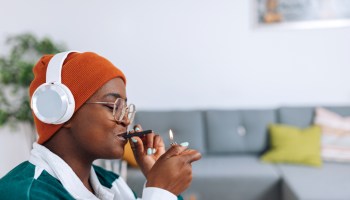In honor of National PTSD Awareness Day on June 27th, HelloBeautiful is launching a two-part series which aims to break down what trauma means to women in communities of color, along with the personal stories of trauma survivors.
Many Black women–who live at the intersections of several disparities are dealing with one or several instances of trauma at once.
We sat down with Miriam Goodman, the director of Justice Home, an alternative to incarceration program for women. The program is run by the Women’s Prison Association in New York City, which offers other programming including housing, addiction treatment, career development and mental health treatment. Participants are usually referred through a court order and are often women of color.
As a mental health awareness professional with over a decade of experience, Goodman offered a distinct definition on the word trauma.
“Trauma ,I think of it as something that happens to an individual and or community that is truly a life threatening experience,” Goodman said. “It battles the core of someone’s understanding of worth and importance.”
When discussing trauma and post traumatic stress disorder, most people recall military veterans who come back from the war with symptoms as the product of their experiences. But along with service in the military, trauma can manifest itself in a variety of ways: sexual violence, domestic violence, racial encounters, gun violence, military service and incarceration.
“People experience a lot of different kinds of trauma and oppression before they walk through your door and we need to acknowledge that,” she said. “It’s not only about the interpersonal victimization that individuals have experienced, it’s also how systems in society at large are traumatizing to individuals and how that has impact on trust, engagement and on the person themselves.”
Goodman explained that trauma is housed in several different experiences: interpersonal trauma which includes, violence (sexual and domestic), non-intentional trauma (natural disasters), and systematic trauma which covers racism, sexism, poverty, homophobia, the criminal legal system and educational racism.
Goodman uses a tree metaphor to break down how communities can better understand how to understand and treat individuals living with trauma.
“We in our program at WPA understand trauma are those traumatic experiences are often those root causes, those roots that live underground–the experiences that people keep down within,” she said.
“What society sees, or what the criminal legal system sees are the leaves and branches. They see one behavior or one moment, or one snapshot of that individual and don’t ever connect it back to the roots,” Goodman said. “Because we don’t pay attention to the roots, those leaves and branches can die. What we do as a society is spray paint the leaves to pretend that they’re okay.”
Goodman calls for an end to band-aid solutions when addressing trauma. She believes that for interpersonal trauma, trauma focused therapy is a great source of healing and wellness and that trauma survivors need to be equipped with the language to describe the experiences along with coping strategies.
There is a long unfortunate history in the medical profession where racism and prejudice often leaves Black women struggling with trauma, misdiagnosed.
Goodman also touched on the friction that is sometimes received as a wellness worker at WPA, where predominantly, white workers who are interacting mostly with women of color. For the larger isms, Goodman suggests that open conversations are important.
“It has come up multiple times where people will say, ‘I don’t really trust white people,’ and instead of shutting that down, like that’s something bad, we have open conversations.” “Let’s talk about why it might be challenging to talk to me based on someone’s negative experiences with racism. I want to explore this with you and hear about it. It happens all the time and I think it’s a very micro way to address a macro problem.”
Also, wellness workers and rehabilitative programs need to work closely with organizations to change policies that reinforce the “isms” that help to enforce trauma.
For Goodman the most important healing aspect for trauma survivors comes from their surrounding community.
“The experience of being treated with dignity and respect and being believed–having your story being heard and not questioned is a very healing experience for many people,” Goodman said.
DON’T MISS:






















